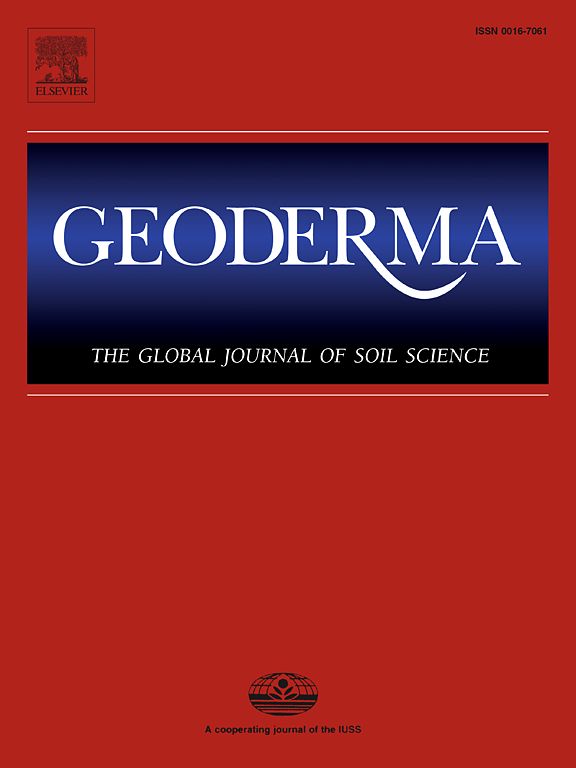Four-dimensional modelling reveals decline in cropland soil pH during last four decades in China’s Mollisols region
IF 5.6
1区 农林科学
Q1 SOIL SCIENCE
引用次数: 0
Abstract
The degradation of fertile Mollisols due to unsustainable management practices poses serious threats to climate change mitigation and food security. Yet, the lack of four-dimensional (4D) dynamic information (i.e., space, depth, and time) on cropland soil pH hinders sustainable soil management. To fill this knowledge gap, over 17,000 soil pH samples were first collected from the Mollisols region in Northeast China. Then, an automatic machine learning model coupled with space-for-time substitution (AutoMLst) was developed for mapping the 4D dynamics of cropland soil pH during 1980–2023. Results showed that AutoMLst performed well in 4D modelling of cropland soil pH, with a coefficient of determination of 0.88. The topsoil (0–30 cm) pH significantly declined from 6.83 in 1980 to 6.43 in 2023 in Northeast China, with an average decline rate of 0.0038 units yr−1 (0.0014–0.0063 units yr−1). The pH declines in the deeper soil layers (30–60 and 60–100 cm) were slight and statistically insignificant. The excessive use of chemical nitrogen (N) fertilizers and N deposition jointly contributed to the decline of cropland soil pH, but the impact of N deposition has increased over time. Although implementing China’s zero-growth policy for chemical fertilizer application will increase soil pH under the shared socioeconomic pathway (SSP) 1–2.6 and 5–8.5 scenarios, the current decline in cropland soil pH should not be overlooked to ensure the health of Mollisols. These findings suggest that the sustainable management of Mollisols resources requires strict monitoring of soil pH dynamics to mitigate potential soil acidification risks.
四维模型揭示了近40年来中国Mollisols地区农田土壤pH值的下降
不可持续的管理做法导致肥沃的软土退化,对减缓气候变化和粮食安全构成严重威胁。然而,缺乏耕地土壤pH的四维动态信息(即空间、深度和时间)阻碍了土壤的可持续管理。为了填补这一知识空白,首先从东北Mollisols地区收集了17,000多个土壤pH样品。在此基础上,建立了基于时空替换的自动机器学习模型(AutoMLst),用于绘制1980-2023年农田土壤pH的四维动态。结果表明,AutoMLst在农田土壤pH的4D模拟中表现良好,其决定系数为0.88。东北地区表层土壤(0 ~ 30 cm) pH由1980年的6.83显著下降至2023年的6.43,平均下降幅度为0.0038 units yr - 1 (0.0014 ~ 0.0063 units yr - 1)。深层土壤(30 ~ 60 cm和60 ~ 100 cm) pH值下降幅度较小,且无统计学意义。化学氮肥的过量施用和N沉降共同导致了农田土壤pH的下降,但随着时间的推移,N沉降的影响越来越大。尽管在共享社会经济路径(SSP) 1-2.6和5-8.5情景下,实施中国化肥施用零增长政策将增加土壤pH值,但为了确保Mollisols的健康,目前农田土壤pH值的下降不应被忽视。这些发现表明,要实现软土资源的可持续管理,需要严格监测土壤pH动态,以减轻潜在的土壤酸化风险。
本文章由计算机程序翻译,如有差异,请以英文原文为准。
求助全文
约1分钟内获得全文
求助全文
来源期刊

Geoderma
农林科学-土壤科学
CiteScore
11.80
自引率
6.60%
发文量
597
审稿时长
58 days
期刊介绍:
Geoderma - the global journal of soil science - welcomes authors, readers and soil research from all parts of the world, encourages worldwide soil studies, and embraces all aspects of soil science and its associated pedagogy. The journal particularly welcomes interdisciplinary work focusing on dynamic soil processes and functions across space and time.
 求助内容:
求助内容: 应助结果提醒方式:
应助结果提醒方式:


